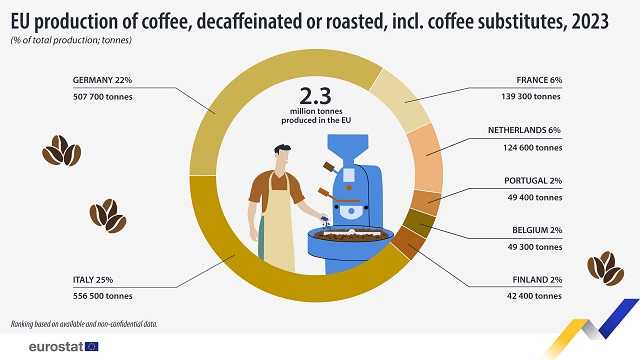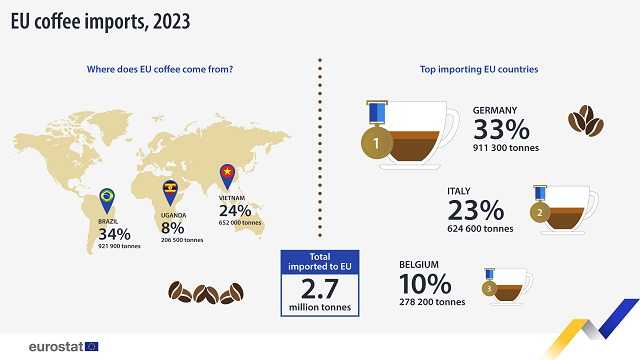MILAN – On the occasion of International Coffee Day – celebrated worldwide yesterday, Tuesday 1 October – Eurostat, statistical office of the European Union, has published some interesting data on the European coffee industry. In 2023, the EU imported 2.7 million tonnes of coffee (45 million 60-kg bags) from non-EU countries, worth €10.6 billion.
The amount remained almost stable compared with 2013 (also 2.7 million tonnes), but the value increased significantly from 7.3 billion in 2013 to 10.6 billion in 2023.
Most of the coffee imported in 2023 came from two countries (see infographic above): Brazil (921 900 tonnes, or 34% of the total extra-EU imports) and Vietnam (652 000 tonnes, or 24%). These were followed by Uganda (206 500 tonnes, 8%), Honduras (168 800 tonnes, 6%), India (118 100 tonnes, 4%), Colombia (112 700 tonnes, 4%), Peru (83 000 tonnes, 3%) and Indonesia (68 300 tonnes, 2%).
Around a third of these imports were made by Germany (911 300 tonnes imported, or 33% of the total extra-EU imports), followed by Italy (624 600 tonnes, 23%), Belgium (278 200 tonnes, 10%), Spain (249 500 tonnes, 9%) and France (184 000 tonnes, 7%).
Italy and Germany: top coffee producers

In 2023, over 2.3 million tonnes of coffee, decaffeinated or roasted (including coffee substitutes) were produced in the EU. The amount has increased by 15% compared with 2013 (1.9 million tonnes), equivalent to around 5 kilograms per inhabitant in 2023. The EU’s coffee production was worth almost €13 billion.
Among the reporting EU countries, Italy produced the most roasted coffee in 2023 (556 500 tonnes, or 25% of the total EU production), followed by Germany (507 700, 22%), which was ahead of France (139 300, 6%), the Netherlands (124 600, 6%), Portugal (49 400, 2%), Belgium (49 300, 2%) and Finland (42 400, 2%).
In 2023, these seven EU countries produced 59% of the total EU production of roasted coffee.














